Polyurethane 101
Want Versatility? Reliability? Durability? Manufacturability?
One material does it all: cast polyurethane.
- Cast Urethanes
- Physical Engineering & Environmental Properties
- Typical Cast Polyurethane Applications
- Consumer Information
- Cast Polyurethane
Cast Urethanes
All engineering plastics and rubbers have combinations of properties which make them useful in industry. The castable polyurethane elastomers have such a broad range of property combinations that they far excel all other engineering materials in versatility. While you may not combine all of the properties below into one article, experienced urethane processors can help you choose those properties needed to produce the most cost-effective product.
- Resilience (high or low)
- Excellent abrasion resistance
- Light weight relative to metals
- Impact and shock resistance
- Bonding to metals and plastics
- Compression modulus (high to low)
- Cut and tear resistance
- Flex fatigue resistance
- Friction (high or low)
- Good electrical properties
- Oil, solvent, water, ozone resistance
- Age resistance
- Mold, mildew, fungus resistance
- Non-marking characteristic
- High load capacity
- Chemical resistanceMachinability
Physical Engineering & Environmental Properties
Urethane rubber will deflect under compressive or impact stress and recover its original shape when the stress is removed. The graph above shows the huge difference between available work from cast polyurethane and that from conventional rubbers at the same hardness and original shape. The area under the curve represents the useful work that the elastomer can do. This graph shows the comparison at 75-80A durometer; the difference becomes much more dramatic as the hardness levels increase. No plastic has these dynamic capabilities.
Progress has been made in finite element analysis as a predictive design tool. Computer calculations are more complex because elastomers have many variables when compared to metals. Also, the failure mechanism in metal is usually in shear while urethane elastomers tend to fail in tension. The photos above are of the top and bottom view of an auger. The red, pink, and white areas pinpoint the high strain area in service, which careful design kept within acceptable limits.
Typical Cast Polyurethane Applications
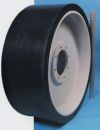

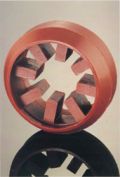
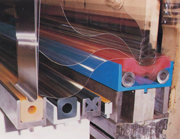
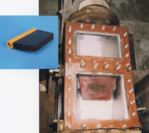
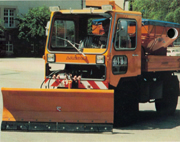
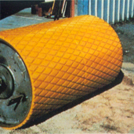

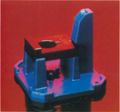

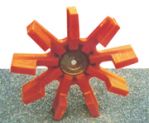




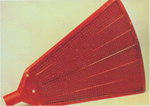
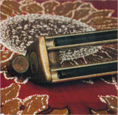
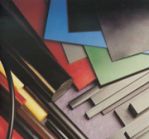
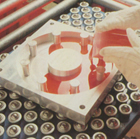
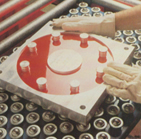
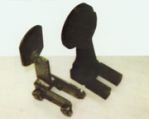
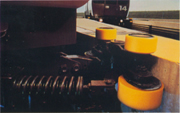


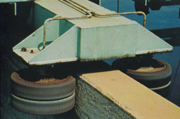
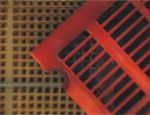

Consumer Information
A polyurethane (PUR and PU) is polymer composed of a chain of organic units joined by carbamate (urethane) links. Polyurethane polymers are formed by combining two bi- or higher functional monomers. One contains two or moreisocyanate functionalgroups (with formula –N=C=O) and the other contains two or more hydroxyl groups (with formula –OH). The alcohol and the isocyanate groups combine to form a urethane linkage:
- ROH + R'NCO → ROC(O)N(H)R' (R and R' are alkyl or aryl groups)
This combining process, sometimes called condensation, typically requires the presence of a catalyst. More complicated monomers are also used.
Polyurethanes are used in the manufacture of flexible, high-resilience foam seating; rigid foam insulation panels; microcellular foam seals and gaskets; durable elastomeric wheels and tires; automotive suspension bushings; electrical potting compounds; high performance adhesives; surface coatings and surface sealants; synthetic fibers (e.g., Spandex); carpet underlay; and hard-plastic parts (e.g., for electronic instruments). Polyurethane is also used for the manufacture of hoses and skateboard wheels as it combines the best properties of both rubber and plastic.
Cast Polyurethane
For many applications, there's a viable alternative to plastic, metal and rubber—one that many OEMs aren't even aware of. It's called cast polyurethane, and it's among the most versatile, durable materials available in manufacturing.
Originally developed by Otto Bayer early in World War II, polyurethane gained traction with numerous applications in the 1950s. Today, with its comparatively low tooling costs, castable polyurethane elastomers are a perfect alternative to more common materials in a variety of applications.
But many product designers may be surprised to learn of polyurethane's physical versatility. Capable of being as flexible as a rubber band or as rigid as some metals, cast polyurethane is especially appropriate for parts that require toughness and durability, including:
- Gears
- Cogs
- Sprockets
- Solid wheels of all types
Here are some of the advantages cast polyurethane has over other materials in low-volume applications.
Vs. PlasticPolyurethane can be formulated for superior load-bearing capability, abrasion resistance, and impact absorption.
|
Vs. MetalOne of the most overlooked characteristics of polyurethane is its ability to be formulated for high rigidity, making it often a viable alternative to metal for hardware such as valves and gears. Cast polyurethane's advanced manufacturability also eliminates the need for secondary operations such as stamping, punching, and painting, which saves time and costs in production.
|
Vs. RubberFeaturing the elastic capability of rubber, while measuring higher on the hardness scale, polyurethane can be a good choice for certain parts because of its:
|

